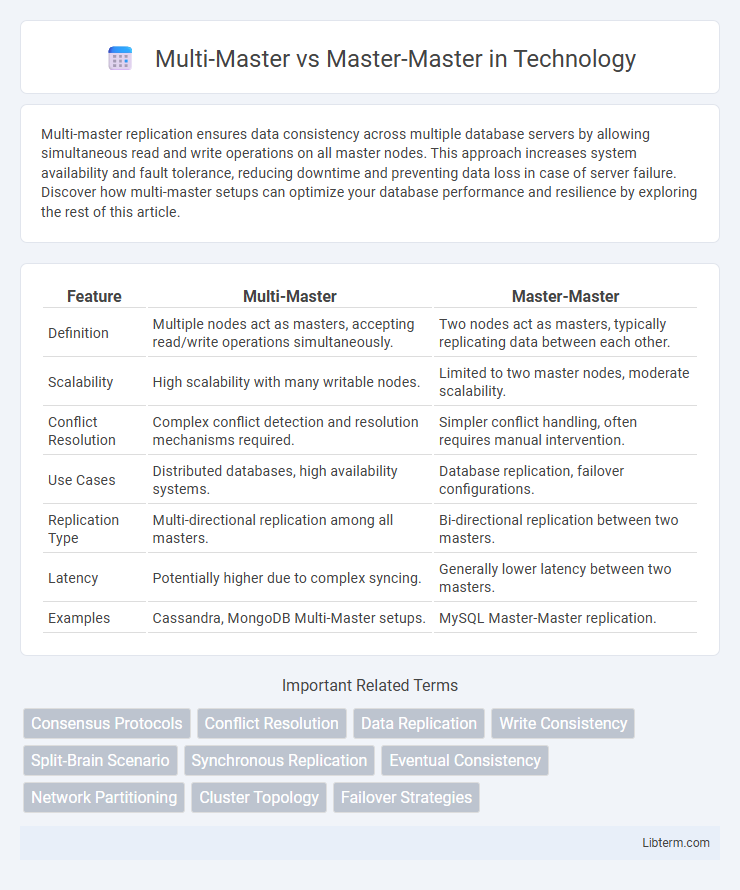Multi-master replication ensures data consistency across multiple database servers by allowing simultaneous read and write operations on all master nodes. This approach increases system availability and fault tolerance, reducing downtime and preventing data loss in case of server failure. Discover how multi-master setups can optimize your database performance and resilience by exploring the rest of this article.
Table of Comparison
| Feature | Multi-Master | Master-Master |
|---|---|---|
| Definition | Multiple nodes act as masters, accepting read/write operations simultaneously. | Two nodes act as masters, typically replicating data between each other. |
| Scalability | High scalability with many writable nodes. | Limited to two master nodes, moderate scalability. |
| Conflict Resolution | Complex conflict detection and resolution mechanisms required. | Simpler conflict handling, often requires manual intervention. |
| Use Cases | Distributed databases, high availability systems. | Database replication, failover configurations. |
| Replication Type | Multi-directional replication among all masters. | Bi-directional replication between two masters. |
| Latency | Potentially higher due to complex syncing. | Generally lower latency between two masters. |
| Examples | Cassandra, MongoDB Multi-Master setups. | MySQL Master-Master replication. |
Introduction to Database Replication Topologies
Multi-master replication involves multiple database nodes acting as both master and replicas, allowing simultaneous read-write operations across all nodes for improved availability and fault tolerance. Master-master replication is a form of multi-master setup where two or more masters synchronize data bi-directionally, ensuring data consistency among nodes and enabling load balancing. These topologies are crucial in distributed database systems to enhance scalability, minimize downtime, and maintain data integrity across geographically dispersed servers.
Defining Multi-Master and Master-Master Architectures
Multi-Master architecture involves multiple nodes acting as masters, each capable of handling read and write operations independently, ensuring high availability and fault tolerance. Master-Master architecture specifically refers to a bi-directional replication setup where two master nodes synchronize data changes to maintain consistency across both servers. Both architectures aim to optimize database performance and resilience but differ in complexity and replication mechanics.
Key Differences Between Multi-Master and Master-Master
Multi-Master replication involves multiple nodes acting as primary servers with the ability to accept write operations independently, while Master-Master typically refers to a specific two-node system with mutual replication and conflict resolution. Key differences include scalability, as Multi-Master supports numerous nodes for load balancing, whereas Master-Master is limited to two nodes focused on redundancy. Conflict management in Multi-Master systems is usually more complex due to multiple write sources, while Master-Master setups have simpler conflict detection mechanisms because of the binary node structure.
Pros and Cons of Multi-Master Replication
Multi-Master replication enables multiple database nodes to handle read and write operations simultaneously, enhancing availability and load distribution. Challenges include complex conflict resolution and potential data consistency issues due to concurrent updates across nodes. While it improves fault tolerance and scalability, managing synchronization and avoiding replication conflicts demand robust algorithms and monitoring tools.
Pros and Cons of Master-Master Replication
Master-Master replication offers high availability and fault tolerance by allowing multiple nodes to handle read and write operations simultaneously, reducing downtime and improving load balancing. However, it introduces complexity in conflict resolution and data consistency, requiring mechanisms to handle potential write conflicts and prevent data anomalies. Scalability can be limited due to coordination overhead, making it less suitable for highly distributed systems with frequent concurrent updates.
Conflict Detection and Resolution Strategies
Multi-Master replication systems enable all nodes to accept write operations, requiring robust conflict detection mechanisms such as version vectors or timestamps to identify data inconsistencies. Conflict resolution strategies often include last-write-wins, vector clock comparison, or application-specific reconciliation to ensure data integrity across distributed databases. Master-Master typically refers to similar setups but can emphasize symmetrical roles with automatic conflict resolution protocols like quorum-based consensus to maintain synchronization and consistency.
Performance Implications and Scalability
Multi-Master and Master-Master replication both enable multiple nodes to handle write operations, but Multi-Master architectures typically offer better write scalability by distributing loads evenly across all nodes. Master-Master setups often face increased conflict resolution overhead and latency as each node synchronizes changes bi-directionally, potentially impacting performance under heavy write contention. Large-scale deployments benefit from Multi-Master systems that reduce single points of failure and balance throughput more effectively, enhancing overall system responsiveness and scalability.
Use Cases for Multi-Master Architectures
Multi-master architectures excel in distributed environments requiring high availability and fault tolerance, enabling multiple nodes to accept write operations simultaneously. Use cases include global applications with geographically dispersed data centers, real-time collaboration platforms, and multi-site enterprise systems that demand seamless data synchronization and minimal latency. These architectures minimize downtime and improve system resilience by eliminating single points of failure inherent in master-master setups with rigid leader election processes.
Use Cases for Master-Master Architectures
Master-Master architectures excel in use cases requiring high availability, fault tolerance, and real-time data synchronization across multiple nodes, such as distributed databases, multi-region applications, and collaborative platforms. This setup allows simultaneous read-write operations on all master nodes, ensuring zero downtime and load balancing in environments where continuous data consistency and accessibility are critical. Enterprises leveraging microservices, global e-commerce sites, or financial trading systems benefit from Master-Master replication by minimizing latency and providing robust disaster recovery capabilities.
Choosing the Right Replication Model for Your Needs
Multi-Master replication allows multiple nodes to accept write operations simultaneously, providing high availability and fault tolerance ideal for distributed systems with frequent data changes. Master-Master replication, often used interchangeably with Multi-Master, typically involves two nodes synchronizing changes bidirectionally, suited for smaller-scale setups requiring conflict resolution mechanisms. Selecting the right replication model depends on factors like system scale, conflict handling requirements, network latency, and consistency needs to ensure optimal performance and data integrity.
Multi-Master Infographic

 libterm.com
libterm.com